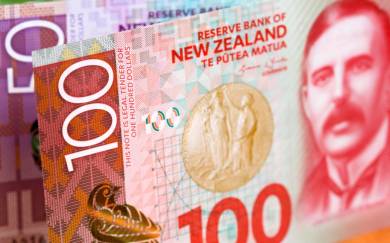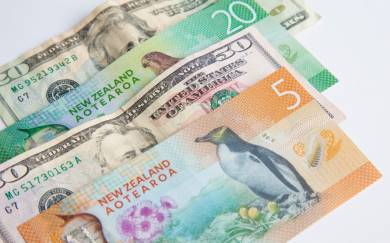Next week RBNZ decides on interest rate. What else? Let's see Craig Erlam's preview

Craig Erlam 18.11.2022 18:22
US
Wall Street’s shortened trading week will be jam-packed with the FOMC minutes, more Fed speak, the flash PMIs and the final look at the University of Michigan’s inflation expectations.
One of the key events of the trading week will be the Fed’s minutes from the November policy meeting. Financial markets will want to know if the Fed still believes that the cost of taking too little action to bring down inflation likely outweighed the cost of taking too much action. The Fed is expected to downshift to a half-point rate-hiking pace in December, but that rate-hiking cycle could last longer if pricing pressures become more entrenched.
US stock and bond markets will be closed Thursday for Thanksgiving Day and will close early on Friday. Traders will pay close attention to Black Friday shopping data, which will give the latest pulse on the health of the US consumer.
EU
The highlight next week may well be the monetary policy accounts, although, with a steady stream of central bank commentary since the last meeting and a raft of economic data, it’s hard to say just how impactful they’ll ultimately be.
The flash PMIs may tell a more interesting story of an economy heading for recession, while appearances from various policymakers – including President Christine Lagarde on Sunday – could fill in any gaps that haven’t already been filled.
UK
It’s hard to get too excited about next week’s PMI data and central bank speak following the assessment from the OBR on the economic outlook, taking into consideration the latest fiscal squeeze. The UK is heading for its largest squeeze on living standards in six decades – a 7.1% decline – as interest rates continue to increase, taxes rise and the cost-of-living crisis intensifies.
The only question that remains is how soon the BoE can pause its tightening among all of these other pressures. It alluded to the fact that markets are pricing in too much at the last meeting but at this moment, another 150 basis points are still priced in.
Russia
Another quiet week on the economic data side, with PPI numbers the only notable releases. The focus remains on its invasion of Ukraine and how it handles recent losses in Kherson.
South Africa
Next week is action-packed, with inflation data being released on Wednesday ahead of the latest SARB rate decision a day later. While the headline CPI is expected to ease slightly to 7.4%, from 7.5%, core is seen rising from 4.7% to 4.9%, meaning both remain far too high. The SARB inflation target is 3-6%.
That is expected to push the SARB to hike interest rates again next week by 75 basis points, taking the repo rate to 7%.
Turkey
The CBRT is expected to cut interest rates by another 150 basis points next week despite soaring inflation and a desperately weak currency. The latter has been managed with capital controls over the last couple of years and the new reserve-management system appears to be stabilizing it at record lows despite continued easing. The hope for President Erdogan is this can be carefully managed into next year’s election to at least give the impression of stability amid a potential deceleration in official inflation.
Switzerland
No significant economic data or releases next week.
The central bank continues to drive home the message that FX intervention could occur on either side. An inter-meeting rate hike can also not be ruled out.
China
The focus stays on China’s Covid situation. China’s Covid cases are near record highs and that is threatening to delay any looser rules. Expectations are now for China to reopen sometime after March.
Investors widely expect Chinese commercial banks to keep both the 1-year and 5-year Loan Prime Rate (LPR) unchanged at 3.65% and 4.30% respectively. The PBOC might be delaying rate cuts until next quarter as they are concerned about yuan weakness.
India
It is expected to be a quiet week for India.
Australia & New Zealand
This week is mostly about New Zealand as the RBNZ is expected to deliver its sixth straight half-point rate hike. Hot inflation and wage data are expected to prevent the central bank from downshifting to a slower pace of tightening. Investors hoping for the bank to pause tightening in February might be surprised if the policymakers are worried that inflation isn’t falling quickly enough.
The lone release for Australia will be the preliminary PMI readings. Last month the service sector fell into contraction territory while manufacturing activity continues to soften.
Japan
A busy week filled with Japanese data, including preliminary PMI data for the services and manufacturing sectors in November and core CPI data for the Tokyo region in November. Inflation in Japan has hit a four-decade high and that is complicating what the BOJ wants to do. Some economists are expecting Tokyo’s core inflation to slow for the first time since January but that is hardly the overall consensus.
Singapore
The October inflation report is expected to show pricing pressures eased from 7.5% to 7.0%. The final Q3 Q/Q GDP reading is expected to be revised a tick lower to 1.4%.
Economic Calendar
Saturday, Nov. 19
Economic Events
The APEC Economic Leaders’ Meeting concludes
Fed’s Bostic speaks at the Southern Economic Association annual meeting in Florida
Sunday, Nov. 20
Events
World Cup begins with Qatar hosting Ecuador
ECBs Lagarde participates in formal dinner of European Roundtable for Industry
Monday, Nov. 21
Economic Data/Events
US Chicago Fed national activity index
China loan prime rates
Germany producer prices
New Zealand credit card spending
Sweden home prices, industry capacity utilization
Taiwan export orders, current account balance
Thailand GDP
The Bank of Japan announces the outright purchase amount of Japanese government securities
Ukraine President Zelenskiy speaks at NATO Parliamentary Assembly’s annual session
ECB’s Holzmann and Simkus speak at the Conference on European Economic Integration hosted by Austria’s central bank
Bank of Portugal Governor Centeno speaks at the CNN Portugal Summit
Bundesbank President Nagel speaks at an evening event of the ICFW Frankfurt business journalists’ club
Tuesday, Nov. 22
Economic Data/Events
US Richmond Fed manufacturing index
Canada retail sales
Euro area consumer confidence
Mexico retail sales, Banamex survey of economists
New Zealand trade
South Africa leading indicator
Turkey consumer confidence
South African President Cyril Ramaphosa is on a state visit to the UK
The OECD releases its latest Economic Outlook
German Chancellor Scholz speaks at the SZ-Wirtschaftsgipfel conference in Berlin
ECB’s Holzmann speaks at the presentation of the Austrian National Bank’s financial stability report
Fed’s Mester gives speech on wages and inflation
Fed’s Bullard participates in a policy panel at the Central Bank of Chile’s annual conference
RBA’s Lowe speaks at the annual CEDA dinner
Wednesday, Nov. 23
Economic Data/Events
FOMC minutes of November meeting
US MBA mortgage applications, durable goods, initial jobless claims, preliminary PMIs, University of Michigan sentiment, new home sales
European Flash PMIs: France, Germany, UK
New Zealand central bank (RBNZ) rate decision: Expected to raise rates by 75bps to 4.25%
Australia PMIs
Mexico international reserves
Russia industrial production, monthly PPI, weekly CPI
Singapore CPI, GDP
South Africa CPI
Thailand trade balance
EIA crude oil inventory report
German Chancellor Olaf Scholz addresses the Bundestag on the country’s 2023 budget
ECB’s de Guindos speaks at the Encuentro del Sector Financiero in Madrid
Thursday, Nov. 24
Economic Data/Events
US stocks and bond markets closed for Thanksgiving holiday
Canada small business optimism
France business, manufacturing confidence
Germany IFO business climate
Japan PMIs, department store sales, leading index, machine tool orders
Russia gold and foreign-exchange reserves
Sweden central bank (Riksbank) rate decision: Expected to raise rates by 75bps to 2.50%
Turkey central bank (CBRT) rate decision: Expected to cut rates by 150bp to 9.00%
South Africa central bank (SARB) rate decision: Expected to raise rates by 75bps to 7.00%
Turkey real sector confidence
South Africa PPI
Mexico publishes monetary policy minutes
ECB publishes accounts of its October policy meeting
EU energy ministers hold an emergency meeting in Brussels
ECB’s Schnabel speaks at the Bank of England Watchers’ Conference
Friday, Nov. 25
Economic Data/Events
US stock and bond markets close early
Retailers hope for a strong Black Friday performance
France Consumer confidence
Spain PPI
Sweden PPI
Germany GDP
Japan Tokyo CPI, PPI services
Mexico GDP, current account balance
New Zealand consumer confidence index, retail sales ex-inflation
Singapore industrial production
Thailand foreign reserves, forward contracts
Sovereign Rating Updates
Switzerland (Moody’s)
Turkey (Moody’s)
Poland (DBRS)
This article is for general information purposes only. It is not investment advice or a solution to buy or sell securities. Opinions are the authors; not necessarily that of OANDA Corporation or any of its affiliates, subsidiaries, officers or directors. Leveraged trading is high risk and not suitable for all. You could lose all of your deposited funds.
Week Ahead - Central banks remain hawkish - MarketPulseMarketPulse

 InstaForex Analysis 18.08.2022 12:42
InstaForex Analysis 18.08.2022 12:42


 Ed Moya 09.05.2022 07:03
Ed Moya 09.05.2022 07:03

 Kenny Fisher 24.08.2022 20:06
Kenny Fisher 24.08.2022 20:06










 ING Economics 17.11.2022 21:11
ING Economics 17.11.2022 21:11

 Craig Erlam 18.11.2022 18:22
Craig Erlam 18.11.2022 18:22




